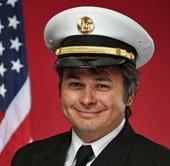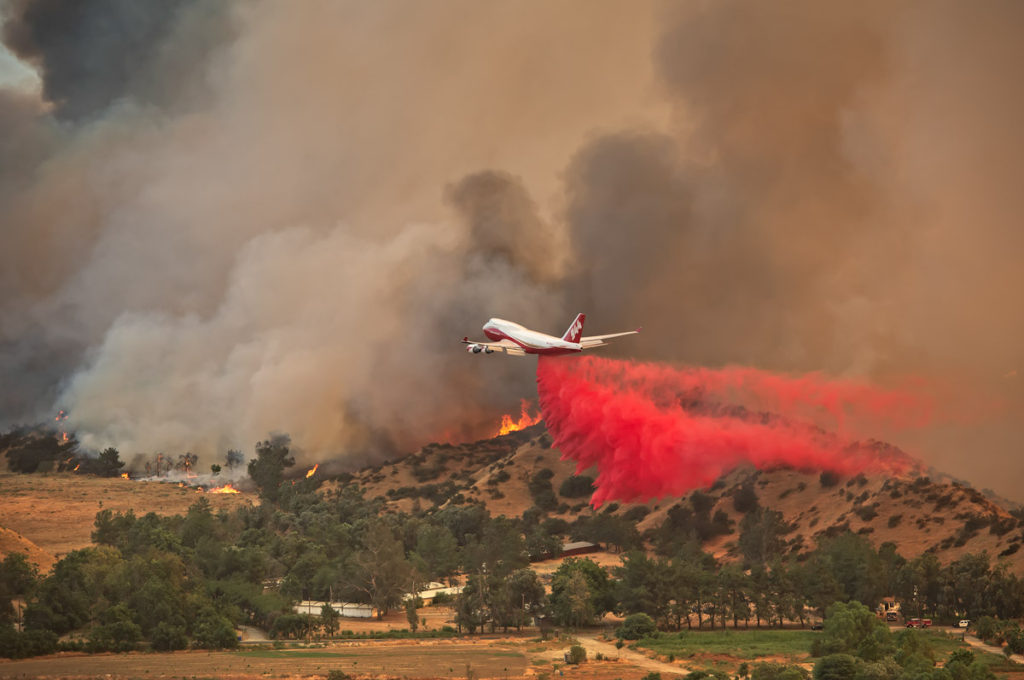The widow of the Draper, Utah firefighter who was killed while fighting a wildfire in Northern California has filed a lawsuit against the California Department of Forestry and Fire Protection (CAL FIRE) and the company that operates the 747 Supertanker, according to a report by the Sacramento Bee.

Matthew Burchett, a 42-year old Battalion Chief from the Draper City Fire Department was killed August 13, 2018 when a retardant drop from the 747 air tanker uprooted an 87-foot tall tree that fell on him. Three other firefighters had different assortments of injuries from sheered-off trees and limbs, including broken ribs, deep muscle contusions, ligament damage to extremities, scratches, and abrasions.
On September 14, 2018 CAL FIRE released what they call a “Green Sheet” report about the fatality and injuries that were caused by the falling tree debris. The accident occurred on the Ranch Fire which was part of the Mendocino Complex of Fires east of Ukiah, California.

Standard procedure is for firefighters to leave an area before an air tanker drops. The report said the personnel on that Division were told twice that day to not be under drops — once in a morning Division break-out briefing, and again on the radio before the fatal drop and three others from large air tankers were made in the area. It was not confirmed that all supervisors heard the order on the radio to evacuate the drop area.
One of the “Incidental Issues / Lessons Learned” in the report mentioned that some firefighters like to record video of air tanker drops:
Fireline personnel have used their cell phones to video the aerial retardant drops. The focus on recording the retardant drops on video may distract firefighters. This activity may impair their ability to recognize the hazards and take appropriate evasive action possibly reducing or eliminating injuries.
The air tanker that made the drop was T-944, a 747-400 that can carry up to 19,200 gallons. Instead of a more conventional gravity-powered retardant delivery system, the aircraft has pressurized equipment that forces the retardant out of the tanks using compressed air. This is similar to the MAFFS air tankers. When a drop is made from the recommended height the retardant hits the ground as a mist, falling vertically, rather than the larger droplets you see with a gravity tank.

In this case, according to the report, the drop was made from approximately 100 feet above the tree tops. The report stated:
The Aerial Supervision Module (ASM) identified the drop path to the VLAT by use of a smoke trail. The VLAT initiated the retardant drop as identified by the smoke trail. Obscured by heavy vegetation and unknown to the VLAT pilot, a rise in elevation occurred along the flight path. This rise in elevation resulted in the retardant drop only being approximately 100 feet above the treetops at the accident site.
When a drop is made from a very low altitude with any air tanker, the retardant is still moving forward almost as fast as the aircraft, as seen in this drop. If it is still moving forward there will be “shadows” that are free of retardant on the back side of vegetation, reducing the effectiveness of the drop. From a proper height retardant will gradually slow from air resistance, move in an arc and ideally will be falling gently straight down before it hits the ground. Another example of a low drop was on the Liberty Fire in Southern California in 2017 that dislodged dozens of ceramic roofing tiles on a residence and blew out several windows allowing a great deal of retardant to enter the home.
Global Supertanker, the company that operates the 747 Supertanker, gave us this statement shortly after the Green Sheet was released:
We’re heartbroken for the families, friends and colleagues of Chief Burchett and the other brave firefighters who were injured during their recent work on the Mendocino Complex Fire. As proud members of the wildland firefighting community, we, too, have lost a brother.
On August 13, 2018, Global SuperTanker Services, LLC acted within procedural and operational parameters. The subject drop was initiated at the location requested by the Aerial Supervision Module (ASM) after Global SuperTanker Services, LLC was advised that the line was clear.
The company is owned by Alterna Capital Partners LLC, of Wilton, Conn.
Thanks and a tip of the hat go out to Tom. Typos or errors, report them HERE.

Canada has a martin Mars sea plane tanker that has a 71,000 gallon Compacity & is the size of a 747.
Why would they have the highest compacity airplanes and we limit our planes to 5000 gallons.
Not fighting efficiently!
Herb, the Martin Mars can hold up to 7,200 gallons, not 71,000. Built in the 1940s, the two remaining have been retired for several years. They had good, productive lives, and I hope they find homes in museums.
Very Large Air Tankers that are working right now, in addition to the 3,000 to 4,000 gallon Large Air Tankers (C-130, RJ85, BAe-146, B-737, and MD-87), are the 9,400-gallon DC-10 and the 17,500-gallon 747.
71,000 apologies.
I read an article in air & Space magazine along with a photo of the Mars Martin Tanker incorrectly stating 71,000.
However, being in CA & watching the news showing helicopters using small baskets of water drops, begs the question ~ where are the C130’s & 747’s that would change the course of these fires.
Something needs to change – Hal Fishman used to question why larger water dropping planes were not used!
Wasn’t he video taping the drop?
Did he video his death?
Way too much of that going on.
Folks on the ground have a job to do, so do your job and clear the line instead of trying to get an awesome video or picture.
these bother me,she will win her case,make millions that we the taxpayers will have to pay (as far as calfire goes) might do so much damage to the 747 program that they will be hurt to the point they cant operate,and whos really responsible? the dead mans crew for not clearing the area.or someone above im,its not calfires fault or the crew of 944.if they didnt get word to clear,then ok,someone should get hammered,but at the same time,when i got nailed in the early 80s by Hoser,i was told we should have known he was in bound,radio call or not..it was OUR fault for not being aware,there were no fingers pointed after the fact etc,sure no one died,but i believe part of my spinal issues date to that incident.im not blaming Hoser,or CDF and im not and havent tried to sue anyone.this woman will win millions and be set,then some guys will wrangle his way into her life,if one hasnt already and her award will then be spent and her life will tank again,then whos she going to sue then?
i may seem uncaring etc,but i do care,i care that someone is suing a state entity once again and will win and the taxpayers have to eat it,and a company will be damaged etc,tthese kind of lawsuits should be outlawed.its a shame the guys dead,but shouldnt be on his head for not taking action to get to a safe zone? sometimes the dead arent victims ,and the spouse never is,ever. hate on me all ya want,this case is just wrong.
I have to agree. I feel for her and the family I really do,however; she married a fireman. All first responding people are at risk of loosing their life each and every day they get out of bed. c’mon a chief in the wrong place at the wrong time there’s more to it than that. The suit is due to that fact insurance policies don’t pay out for negligence. They are taking precautions , covering themselves in case this report comes back hes at fault.
Again i say to all, my hat goes off to all our brave first responding personnel, they do risk loosing their lives everyday for us. I thank all of you.
On the topic of radio’s, I have been know to listen to scanners during fire season some of these guys complain about their radios being garbled this needs to be improved tremendously.
According to other reports she is only seeking $75,000 to cover the cost of the funeral and related burial expenses. There has been nothing to indicate she is seeking millions of dollars or attempting to bankrupt the department. Frankly, that’s a drop in the bucket compared to what she lost.
My source is KCRA.com “Family of firefighter killed battling California wildfire sues Cal Fire”, if you are interested in fact checking my comment.
I searched and that was the only article about the lawsuit I could find that mentioned the dollar amount. Here is a link, and quote from the article:
Speculation?
A radar altimeter tells you how much air is under you, not what is ahead along the flight path.
True
I’m not sure this terrible accident has anything to do with the 744 as it was cleared to drop by the ASM, and as already has been stated – ground is never level – all of the focus needs to be on supervision on the ground and the real-time tracking of firefighters when dealing with large complex wildfires, relying on radios to ensure an area is cleared prior to an airdrop needs to move into the 21st century.
The technology already exists to allow real-time tracking of EVERY person and asset involved in a wildfire. It’s just a budget and implementation issue that needs to be resolved.
The safety of firefighters should be the number 1 priority and that should include an understanding of the terrain, location of firefighters in real-time, and assets being used both on the ground and in the air.
The technology exists. However, just becouse the info is available does not make it practical. Task saturation is a real thing. Having one more screen to deal with, technology to use and integrate into an already difficult environment may not make it any safer.
And not just in aviation. Ground personnel have similar issues.
It would be interesting to know what coverage level was being used at the time of the drop.
At times, I think the attitude of the ASM is “bigger and more is better”. Time to start using the retardant “effectively”.
RIP Mr. Burchett – you will not have died in vain – hopefully your death will change how retardants are applied.
Not to minimize this incident. It was a tragic loss. If you have been in the wildfire “business” you know that lower than 150 agl feet drops happen. As I was told once by a well seasoned tanker pilot, “there is no such thing as level ground”.
Obscured by heavy vegetation and unknown to the VLAT pilot, a rise in elevation occurred along the flight path. This rise in elevation resulted in the retardant drop only being approximately 100 feet above the treetops at the accident site.
Radar altimeter?